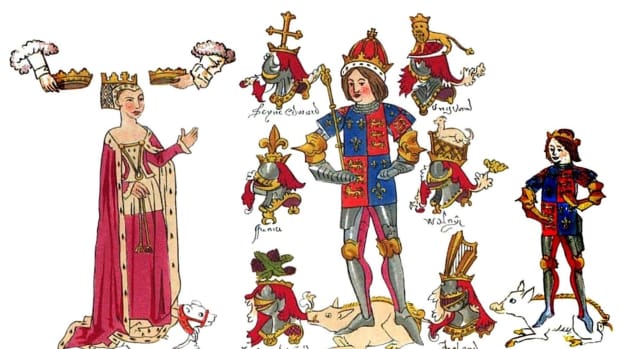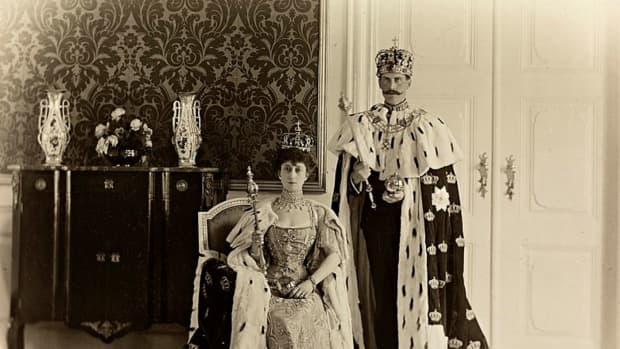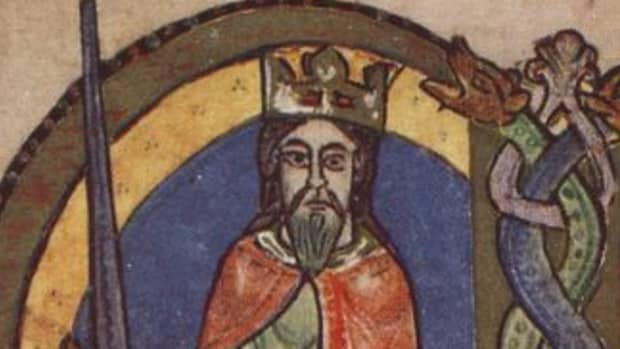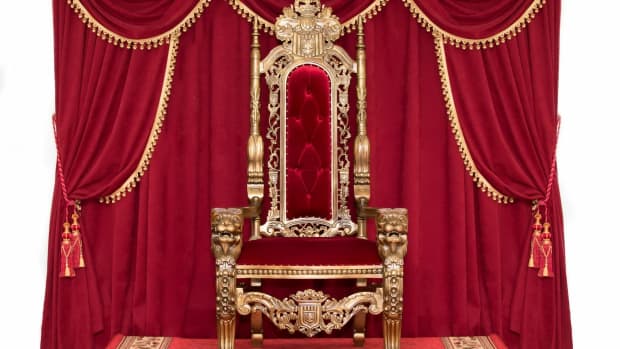King John's Illegitimate Daughter: Joan, Lady of Wales
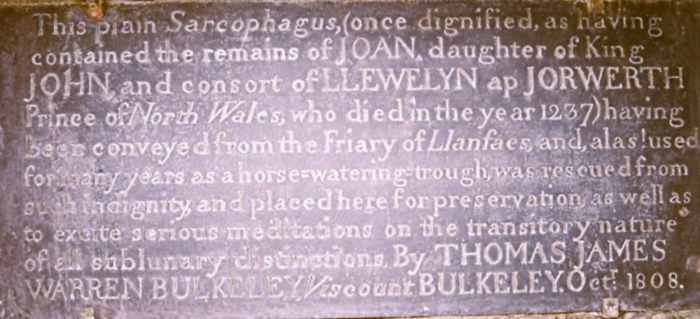
Joan, Lady of Wales' grave in Beaumaris on the Isle of Angelsey off the north coast Wales.
Wikipedia/Catte28 Public Domain
Joan: King John's Daughter
Joan, Lady of Wales was the only known illegitimate daughter of England's tyrannical King John, best remembered for his war with the English barons and his resistance to the 1215 Magna Carta.
John was married twice, and he had five legitimate children. He also had at least five illegitimate sons and Joan.
In the 13th century Tewkesbury Annals written by Benedictine monks, Joan's mother was called "Regina Clemencie", and historians have surmised that the most likely woman to have been John's mistress was Clemence de Verdun, nee Dauntsey from Wiltshire.
Joan's birth date and early history are unknown; the first probable record of Joan's existence dates back to 1203 when King John paid for someone listed as the "king's daughter" to travel from Normandy to England.
The following year, Joan was betrothed to the ruler of Gwynned in Wales, Llywelyn ap Iorwerth or Llywelyn Fawr, "the Great". They married in the city of Chester on an unrecorded date in spring 1205. She was known as Siwan in Welsh.
Joan was a much needed intermediary between King John and Llywelyn the Great. England and Wales' rulers were rarely at peace because the English king was an overlord of the Welsh rulers and their interests differed.
Siwan or Joan, Lady of Wales
During the early weeks of her marriage, Joan successfully persuaded King John to cancel his planned incursion into Wales as she had learned about a plot to kill or incarcerate him.
Llywelyn was expected to be unswervingly loyal to John, which at times he wasn't, and it's probable that Joan tried to advise her husband how to achieve his aims and how to maintain the fragile peace with England.
Despite Joan's peacekeeping efforts, at one time John was so displeased with Llywelyn that he commanded him to send aristocratic Welsh hostages to him, including Gryffud ap Llywelyn, Llywelyn's illegitimate son; to surrender tracts of land and to pay substantial fines. At another stage, Llywelyn received papal approval to invade England.
Llywelyn and Joan had 3 children named in records as Gwladus Ddu, Elen and Dafydd. Perhaps they had more. Llewelyn had at least 4 more issue, but these were not attributed to Joan and Llywelyn had a mistress.
Another of Llywelyn's children, Elen the Younger ferch Llywelyn married John Erskine, 6th Earl of Mar and one of their daughters, Isabella, married Robert the Bruce in 1295. Their daughter Marjorie Bruce was the mother of Robert II, the first Stuart king of Scotland.
Joan, Lady of Wales Legitimised By Pope Honorius II
Wales became a principality in 1216, ruled by Llywelyn, the other Welsh leaders paid homage to him. He was the Prince of Wales although he didn't often use the title.
After King John's death in October 1216 and the accession of Joan's 9 year old half-brother Henry III, the chroniclers didn't speak about Joan for around 4 years. She reappears in 1220 when she and her son Dafydd were taken into the care of the English crown when Llewellyn was due to name Dafydd as his heir, with Henry III and the pope's agreement.
This precaution was taken because in Wales a son, legitimate or illegitimate, had equal rights to succeed the father and Llywelyn had an illegitimate son Gryffud ap Llywelyn. (Gryffud was imprisoned by Llywelyn and Dafydd during their reigns. His days ended in 1244 as he tried to escape incarceration at Henry III's hand in the Tower of London).
A papal bull was passed by the pope in 1222 that disallowed illegitimate sons from usurping legitimate heirs and in 1226, to strengthen Dafydd's position further, Pope Honorius II legitimised Joan. He judged that: "Rex anglie solutus te genuerit de soluta" - King John was unmarried when he fathered her. (Was he?)
"In this year William de Breos the Younger, lord of Brycheiniog, was hanged by the Lord Llywelyn in Gwynedd, after he had been caught in Llywelyn's chamber with the king of England's daughter, Llywelyn's wife".
— The Chronicle of Ystrad Fflur, 1230.
The William de Braose Scandal
Three failed English invasions of Wales tested familial relationships in 1223, 1228 and 1231. In 1224 Joan was granted safe passage to the English city of Worcester to negotiate with King Henry III and in 1228 she made the journey to Shrewsbury to calm matters but Henry confiscated some of her English lands. In November 1229 Joan and Dafydd ap Llywelyn travelled to London to pay homage to Henry III in Llywelyn's name.
1229 brought the most dangerous moment in Joan's life. She was discovered in Llywelyn's bedchamber with Dafydd's father-in-law William de Braose, also spelled de Breos. Llywelyn suspected that they were lovers and he ordered William de Braose's public execution on 2nd May 1230.
Joan was imprisoned for approximately a year before Llywelyn restored her freedom and her position at court.
She died on 2nd February 1237 in Aber Garth Celyn in North Wales when she was probably in her 40s. Llywelyn had her buried in Llanfaes on the Isle of Anglesey, off Wales' north west coast. According to a plaque in nearby Beaumaris, her empty tomb spent time as a horse trough before being rescued in 1808.
In 1237, Llywelyn suffered a stroke and Dafydd took on an increasingly important role as his father's health ebbed away. On 11th April 1240 Llywelyn died and he was buried in Aberconwy Abbey in Gywnedd, across the water from his late wife.

Llywelyn the Great with his sons Dafydd and Gruffydd. Daffyd was legitimate, Gruffydd was illegitimate.
Wikipedia Public Domain
Sources
- JOAN (SIWAN) (died 1237), princess and diplomat | Dictionary of Welsh Biography
- Joan, Lady of Wales, wife of Llywelyn the Great, Prince of Gwynedd | Unofficial Royalty
- Illegitimate children of King John: plantagenesta — LiveJournal
© 2024 Joanne Hayle





